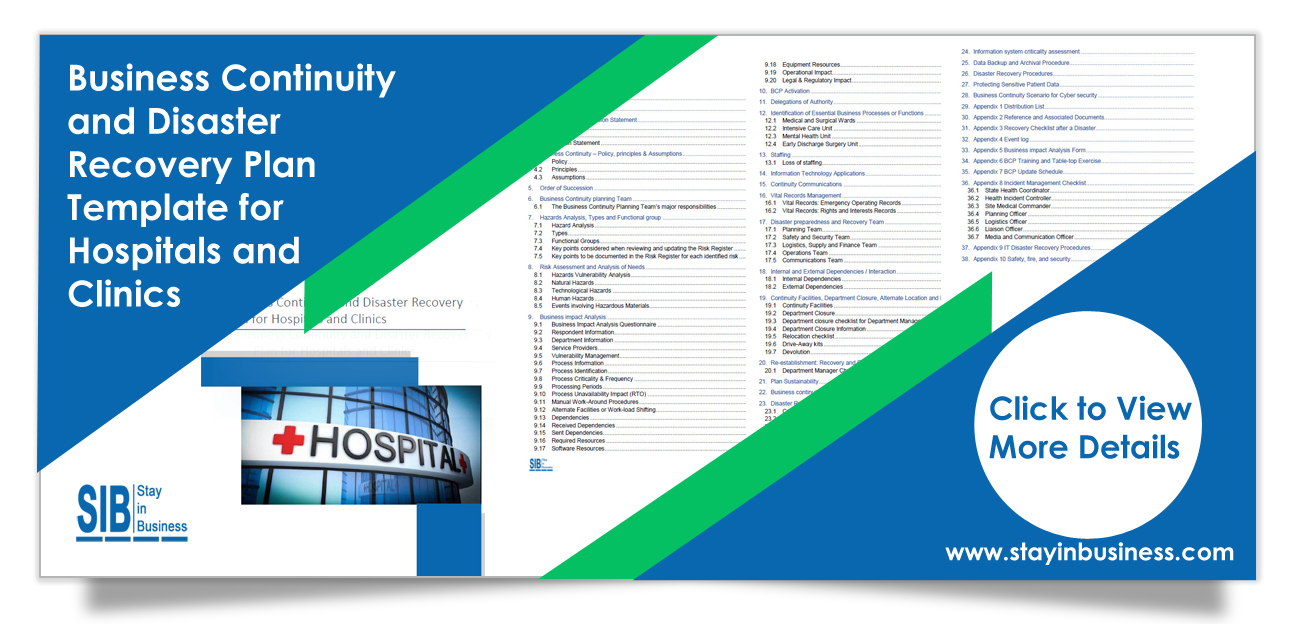
Does your hospital have the resources and technology to meet today’s business continuity requirements? What about a robust plan? A solid business continuity plan will assist you in avoiding downtime in the event of natural disasters, security threats, and other threatening events. Business continuity plans should be so robust that it becomes essential to cover between four to six weeks of continuity in the wake of an attack. Covered entities nowadays have the priority to ensure they are prepared for a potential fallout by reviewing every aspect of the organization.
In the first place, why do hospitals and clinics need a business continuity plan? The answer is a robust business continuity plan helps to mitigate risks and minimize exposure to vulnerabilities. Patients trust hospitals and clinics with their data, and any downtime will be expensive and lead to poor patient care. The Joint Commission and few other accreditation bodies mandate hospitals to implement emergency preparedness programs. Government regulations including HIPAA require hospitals to secure all medical information, which calls for a robust information security program.
Besides HICS (Hospital Incident Command System) which can be used by any hospital to manage threats, emergency incidents, or planned events, hospitals should also concentrate on IT disaster recovery capabilities. As hospitals are becoming more dependent on IT applications to store patients’ medical information, a solid IT disaster recovery program is needed to make sure that applications are available to facilitate medical professionals in treating patients. High availability of systems is a major factor in patient satisfaction. There should be no room left for risk; a robust business continuity/disaster recovery plan is a must for hospitals and clinics.
And what about a disaster recovery plan? Is it important for hospitals and clinics? Business Continuity and Disaster Recovery Work Together
Disaster recovery involves getting all essential IT infrastructure and operations up and running in the event of a disruptive event. It’s a reactive process that happens when critical operations have been interrupted or stopped totally.
Business continuity goes beyond having redundant systems. It’s an exhaustive approach that lets critical services to be delivered without interruption. Business continuity also looks into the call center, mission-critical systems and applications, and staff. Business continuity generally considers not only disaster scenarios but other disruptions including departure of major staff, vendor/suppliers/stakeholders concerns, or any other challenges.
Who are we?
SIB provides a full spectrum of business continuity planning, disaster recovery planning, risk analysis, and Business Impact Analysis (BIA) services adhering to industry-best practices. SIB offers certified subject matter and industry-specific expertise in all aspects of an engagement. Besides BCDR consulting services, SIB provides a state-of-the-art, cloud-based business continuity planning, maintenance and execution platform along with emergency notification for hospitals and clinics to host economic BCDR plans in a fail-proof infrastructure. The dream of using the cloud for business continuity is now an easy accomplishment for hospitals and clinics as they need to pay only for the services used by them. During a disaster, the cloud for business continuity can be accessed by hospitals and clinics from anywhere.
Services Offered
1.Business Continuity Planning
Risk Assessment:
Identification and assessment of variables that affect the level of exposure to your mission-critical business functions will help you to realize your business availability goals.
Business Impact Analysis
Identify and assess the potential effects of an interruption to essential business operations and IT applications following a disaster and assign and build RTO and RPO values according to best practices and industry standards.
Strategy Development
Apply the BIA results to identify resource requirements, perform gap analysis to identify the differences between the recovery requirements and existing capabilities, and form recovery options.
Plan building
Generate business continuity plans that effectively address people, technology, facility and other disruptions to your business.
Testing and training
Business continuity plans are not simply theoretical; they need to be robust enough to be implemented. This is where the role of testing and training arises.
2. IT Disaster Recovery Planning
Perceived and unpredicted threats to functioning are a major concern for hospitals and clinics. In the event of a disaster, the continued functioning also relies on the ability of the hospitals and clinics to replicate their IT systems and data. Here is where the importance of a disaster recovery plan arises.
If hospitals and clinics have a good disaster recovery plan, which is a major subset of the business continuity plan, they will be well-equipped to continue operations in the event of a disaster. The key is in hospitals and clinics being assured that they maintain resiliency in the event of a disaster and also after the incident.
Criticality levels are assigned to applications systems as per the relative significance of the applications and systems to the hospital and clinic mission and operations. At the time of the disaster recovery process, resources will be assigned depending on established criticality levels, unless otherwise determined by the administrative leadership. The Hospital and Clinic will in advance review all applications, systems, networks, and critical interfaces and assign them to specific priority levels.
A good BCP with a DRP in place is crucial to maintaining the smooth functioning of hospitals and clinics by facing interruptions of any kind, comprising natural disasters, human-made disasters, IT system crashes, power failures and more, thus mitigating the short-term negative impact on hospitals and clinics.
Building business continuity plans by considering IT disaster recovery also for hospitals and clinics with multiple teams, departments, and divisions should be managed systematically. A business continuity planning template along with an ITDR plan is a blueprint for strategies to deal with the crisis.





